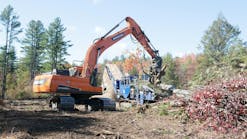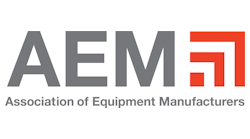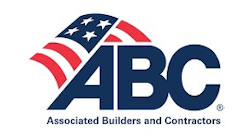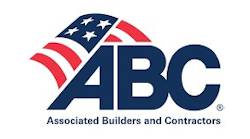When he’s discussing machine control and guidance, Tom Bucklar, marketing consultant for Caterpillar’s Cat Electronics business unit, thinks high tech while he makes a distinction between the two. “When we talk about machine guidance,” says Bucklar, “we mean the operator is being guided about where to move the blade using a laser or GPS reference. When we talk about machine control, we mean this information is tied into the machine’s hydraulics to automate the blade.” Mike Bank of Apache Technologies in Dayton, OH, also talks about machine control. Apache Technologies provides visual-indicate machine control systems. Bank says, “[It’s] basically the same thing as a handheld detector but much larger. It goes on backhoes, excavators, or bulldozers and works with a rotating laser. It will visually guide the operator by telling him whether he’s high, low, or on grade, and he can move the blade accordingly. This means that rather than having a person who checks grade with a rod or the operator having to hop on and off a piece of equipment all day, he can check grade while he’s moving along.”Joseph A. Guerrera Jr., president of Guerrera Construction Company Inc. in Oxford, CT, opted for machine guidance, installing Topcon’s two-dimensional guidance system on his John Deere 772H motor grader because he sees more and more engineers specifying the use of laser graders“You’ve got your engineer, grade checkers, and operator all sitting in the cab of the equipment,” says Garrett. “On a good-size project where you’d ordinarily expect to do a month of fine grading, we typically cut that in half. Whether you’re cutting or filling, you don’t cut too much or fill too much. There’s none of that OLet’s get it into within a half a footBecause of the range of function, and therefore price, the general consensus is that contractors should be clear about the kind of work they’re doing or are planning for the future before they buy. Bank describes a typical Apache Technologies customer as a small-size contractor who does mostly pads or other type of level plane work and probably doesn’t have the resources to invest in automating machine hydraulics. Dave Kawano of Laser Reference in Campbell, CA, markets a basic machine-control laser receiver (model MC-1) to contractors specializing in trenching and excavation. The receiver is attached to the stick of a backhoe and provides the operator with a visual elevation display. Similar to everyone else, Kawano agrees earthwork machine guidance and control are here to say. “All of these systems reduce the need for manpower and staking and greatly increase grading and excavation production.”Dave Scott, who helped establish Topcon’s northeast distribution network, also thinks automation is the wave of the future. “The kids coming out of school today don’t want to be motor-grader operators. They want to be computer-based civil engineers; they’re software savvy.”“Bids are getting tighter,” says Tom Walratch, manager of the Topcon Division at Miller-Bradford & Risberg Inc. in Suffix, WI. “It’s not enough anymore to put in an extra 10% for materials and see if you hit it. Plus the engineers are getting a lot fussier. The equipment they check grade with is getting better.”Right now only two aftermarket companies, Trimble and Topcon, dominate the machine control market, but less than a year from now you’ll be able to buy a Caterpillar G Series track-type tractor with a factory-installed Cat AccuGrade laser grade control system, and you’ll eventually be able to buy it equipped with 3D GPS grade control. Last year Cat and Trimble formed a joint venture, Caterpillar-Trimble Control Technologies, to address machine guidance and control, and the new Cat AccuGrade products are a result. Trimble’s aftermarket SiteVision GPS, along with its laser products, is also marketed out of this joint venture. “Caterpillar has realized that these technology attachments to our machines are providing our customers with 30%-plus productivity gains,” says Bucklar. “These are technologies that are not only increasing productivity but moving the industry forward. We also know there is real value to deeply integrating these technologies into Cat machines, so Caterpillar has made the strategic decision to launch the AccuGrade line of grade control systems. We are confident that by putting our company and our dealerships behind these technologies, our customers and the industry will achieve significant gains.”
“You can use a laser on a flat building pad or on a road that has, say, a crown of 2%,” notes Tim Tometich, GPS division manager for McAninch Corporation in West Des Moines, IA, which has tested machines and guidance systems for both Trimble and Cat. “But it doesn’t work on a surface like a golf course that is moving up and down longitudinally. Before GPS machine control you could only set the blade at a certain percentage and grade it that day. You couldn’t move up and down as far as height or vertical in the same direction. Take a typical residential subdivision. Before we equipped our machine with 3D machine control, we’d have a surveyor stake it and we’d basically grade by reading the stakes. Then when we got ready to pave the job, we’d take out a laser, set up the transmitter, and do a final grading. With 3D there’s no staking, so we can start faster, and if there are any changes, we can do that in the field using the CAD file or design file. And we’re using machine guidance and automated control throughout the job not just for the fine grading at the end. The operator knows at all times where he is on the site and what he should be doing. There are countless efficienciesMcAninch does more than $100 million a year in grading and underground utilities, and founder Dwayne McAninch sits as a contractor-member on the board of the Caterpillar-Trimble joint venture. Tometich figures the company probably has the largest fleet of Trimble SiteVisionequipped GPS equipment in the Midwest, if not the country. “We started in 3D machine control back in 2000,” says Tometich, “but we started with GPS a year earlier with a survey grade system that we used to check existing topography before we actually bid a job. Now we’re using SiteVision on dozers, motor graders, and scrapers. We have it on one excavator and on many of the foremen’s pickups. If you’re just getting started in this and you do mostly small-site jobs, your best bet would probably be to put it on your finish dozer first. If you’re laying rock for a major highway project, you’d probably want to equip your motor grader. If you’re doing mass earthmoving and you’re loading off-road trucks, I would say an excavator is a good applicationIn Arkansas, where Garrett Satellite Driven Excavation brings in between $7 million and $8 million annually grading large commercial projects, Garrett is in his third season using 3D GPS on his grader and dozer. “Before this,” says Garrett, “we had laser and sonic trackers, and we had to manually stake all the breaks in grade. We could grade a flat building pad pretty quick and a single-plane parking lot, but a rolling-hill parking lot was time-consuming. We didn’t want just an indicate system, we wanted to be automated“What we do is go out and stake the job just as we would if we had no machine control capabilities so the operators who don’t have GPS know what’s going on. We cut it based on our stake, and when we get it close, we have our two GPS machines go right behind the other equipment cutting grade. Once you get it within a couple of tenths, it will cut to grade the first pass. If I were building shopping centers I would spec this equipment because it eliminates so many human errors. And for the contractor it saves time on your layout and engineering and on your finish time. In fact it speeds up the whole project because you don’t overfill or undercut. The other thing is that because we can get in and out faster, we can do smaller jobs between the big jobs. All our GPS equipment will also run lasers and sonic trackers“In the past, the concept of stakeless grade control has been limited to fine-grading applications using a laser transmitter as the reference,” says Bucklar. “The laser grade control system’s main advantage has been and still is very high precision. Its limitation is that it operates in only two dimensions, which makes laser systems ideal for grading a flat surface that requires millimeter accuracy. With 3D systems, you’re taking the actual electronic design file and putting it right in the machine, so the machine now knows what the job is supposed to look like in 3D. With the GPS technology, the machine also knows the three-dimensional position of its blade within 2 to 3 centimeters. With these two pieces of information onboard, the operator can start working to the plan without referencing grade stakes. Three-dimensional GPS technology has taken the concept of stakeless grade control from fine-grading applications into the full spectrum of earthworks while taking the double-digit productivity gains along for the ride. Now whether it is a golf course or a building pad, there is a technology that will allow the blade to automatically work to the plan.”DeWayne Cox of Cox & Sons Contracting Company in O’Fallon, IL, has Topcon’s 3D GPS-Plus on two scrapper pans and one bulldozer and will probably put it on the new D8 dozer that’s next on his wish list. “We decided last year was the year because so much of the work around here is GPS. Before that it was strictly engineering stakes for our roads“Most of our jobs are progressive where there may be two, three, four, sometimes five phases spread over a couple of years. With GPSNot everyone, of course, wants to be that high-tech. Right now Tom Debeck, president of Speedway Sand and Gravel Inc. in Middleton, WI, is satisfied with 2D. “One advantage of being in the curb business and having to put up a string line anyway [is that] we’ll put it up early and use it as a grading tool. We’ll probably get into 3D GPS, but this year we’ve got a lot of street work, so we’re using it in simplified form.” Asphalt paving contractor Mike Ammon of BR Ammon and Co. in Elkhorn, WI, uses Topcon’s 2D system on graders to fine-grade gravel. “We’re not working off a model,” says Amman, “we’re working to grade spec. In Wisconsin you get a bonus if you hit a certain ride. If I’m under I get a bonus, but if I’m over I get a deduct. That’s why it’s important to have both my graders and my pavers equipped.” Sam Bowers of Unlimited Concrete Solutions in Washington Court House, OH, says the company uses Tampa, FLbased Laser Leveling’s Skidmaster Pro on its Case skid-steer to do fine-gravel grading before laying concrete. “Recently we used it to prepare a sub-base on a 60,000-square-foot floor,” says Bowers. “Typically we’d have several Bobcats out there spreading gravel, but with this system we had one Bobcat and one operator who did the whole floor. Afterward we took 32 shots and every one of them was right on. The other big benefit is that after we did our sub-base and laid out our forms, our concrete came in within a half a yard of what we had figured. Gravel’s cheap but concrete usually runs close to $60 a yard.” In Connecticut, Guerrera Construction Company installed a Topcon 2D system on its motor grader last year for a project that included a football field and six tennis courts and required laser grading. “The football field required that we laser grade the subgrade and submit an engineered plan of it for approval,” says Guerrera. “The next step was to install the topsoil and laser grade it prior to spreading the seed and provide a final engineered as-built. The paving equipment we used was already equipped with some Topcon equipment, making our slope laser-compatible. During the installation we ran the screed off the slope laser and were able to pick up the cross-slope laser and use it for our pitch on the tennis courts. On this one job alone, with two applications the effectiveness of the equipment just about paid for itself. We are currently working on another high school with several sports fields and tennis courts and also seven buildings. We intend not only to utilize this equipment for the grading of the fields and tennis courts but also to laser grade the seven building slab areas before we pour the concrete.“Had we not had this system we would have done it the old-fashioned way, pulling a string line and checking at every stationContractors currently using 3D GPS control systems caution that anyone considering 3D should be aware they will be facing some changes in how they do business, with more effort going into the job before the equipment goes into the field. This is fundamentally a process of transferring information off a CAD file to model the job, then downloading this 3D model into the machine. “You can build a model for a good-size job in a day, day and a half in the office,” says Garrett. “Basically what you’re doing is sitting in front of your computer making sure all of the elevations and grades in the computer match the blueprint. The machine is going to grade the job exactly as you put the information in the computer, so it’s important to take your time and be careful. We estimate the job with takeoff software, and then once we win the bid or obtain the job, we call and get the CAD file from the owner or engineer. Usually these files are two-dimensionalCox, who refers to this process as “changing information from engineering language to dozer language,” farms out his conversions. “Topcon supplies a software program that basically does all the conversions. I could do it in-house, but I wanted to get a design engineer to do it for me, frankly because I don’t have the time. It costs me about $250 per job.” Tometich emphasizes the importance of assigning someone to handle the software and build the files. McAninch does about 85-90% of its conversions in-house, farming out some of the larger highway projects, and Tometich admits that some contractors are finding data transfer a challenge. “It’s really just a learning curve, and it would help if the engineering community would design in true three dimensions. Right now we’re slowed down because of that.”And once the information is downloaded into the equipment in the field, how do the operators take to 3D? Garrett says his operators are enthusiastic. “Those who don’t have it on their machines want it.” Tometich says the system helps upgrade operator skills. “Give the GPS technology to experienced operators, and they become even better workmen.” “The biggest thing I try to drill into their heads,” says Cox, “is don’t think too much. I tell them, ‘You’ve got a blade and a proposed grade. On the screen the dozer blade is yellow and the proposed grade is green. Just keep the green thing on the yellow thing.’ Some of them worry the machine might be wrong. I tell them I’m betting on the machine.” So where do we go from here? “Three-dimensional machine control is becoming the standard,” says Cox. “If you’re going to be doing any kind of commercial work, you’ve got to have it.” Garrett thinks contractors will have to have it or they’ll be going out of business. “It’s going to be like going from cables to hydraulics.”








